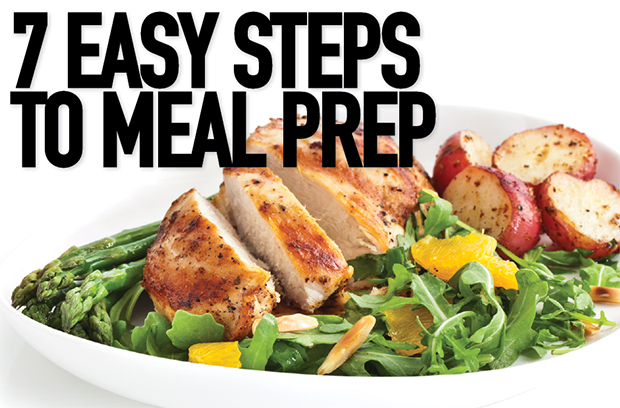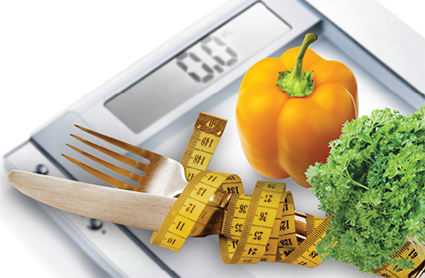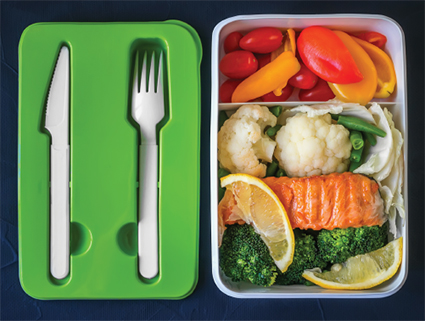7 Easy Steps to Meal Prep

When it comes to determining your caloric needs based on your physique goals … we play by the numbers
 It’s probably no surprise that the less time you spend on prepping and planning your meals, the less likely you’ll be to reach your goals. Meal planning leaves little room for error. It provides you with a predictable and consistent calorie and macro intake, which ensures better body composition, better recovery, and better results. Without tracking your calories and macros, you will of course experience less than optimal results, no matter how hard you work out. So how do you meal prep for success? Keep reading to learn everything you need to know about meal prep in seven easy steps.
It’s probably no surprise that the less time you spend on prepping and planning your meals, the less likely you’ll be to reach your goals. Meal planning leaves little room for error. It provides you with a predictable and consistent calorie and macro intake, which ensures better body composition, better recovery, and better results. Without tracking your calories and macros, you will of course experience less than optimal results, no matter how hard you work out. So how do you meal prep for success? Keep reading to learn everything you need to know about meal prep in seven easy steps.
Step 1: Determine the Basic Amount of Calories You Need to Live
The first step in developing a custom meal plan is to determine your basal metabolic rate (BMR). This is the measure of the calories you need to sustain daily function. You can calculate your BMR in two ways: the Mifflin St Jeor equation or the Harris–Benedict equation. Most online BMR calculators use one of these equations. Research suggests that there’s no statistically significant difference between the equations, so for this example, let’s use the Mifflin St Jeor equation.
BMR for Men:
(10 × weight in kg) + (6.25 × height in cm) − (5 × age) + 5
BMR for Women:
(10 × weight in kg) + (6.25 × height in cm) − (5 × age) − 161
For example, let’s assume the following: You’re a 28-year-old, 80 kg male of 185 cm who’s training five or more times per week to gain as much muscle as humanly possible.
BMR = (10 × 80 kg) + (6.25 × 185) − (5 × 28) + 5
BMR = 800 + 1156 − 140 + 5
BMR = 1811
A body composition analysis using a bio-impedance scale is another way you can determine not only your BMR but also the amount of lean muscle compared to the amount of fat you have on your body. The next step after determining your BMR is to determine your total energy expenditure (TEE).
Step 2: Determine Your TEE
TEE is a combination of your BMR and your activity level, which will give you a total amount of calories you expend in a day.
TEE = BMR + Activity Level
|
Activity Level |
TEE (Kcal) |
|
No Exercise (0 to 1 hour/week) |
BMR + 200 |
|
Mild Exercise (1 to 3 hours/week) |
BMR + 400 |
|
Moderate Exercise (4 to 5 hours/week) |
BMR + 500 |
|
Heavy Exercise (6 to 8 hours/week) |
BMR + 700 |
|
Extreme Exercise (9 or more hours/week) |
BMR + 1000 |
This means our male gainer would calculate TEE as follows:
Example: TEE = 1811 + 700 = 2511 Calories
Step 3: Calculate Your Total Calorie Needs
Once you have the total amount of calories your body needs, the next step is to account for your goals. Do you want to lose weight, maintain your current condition, or gain muscle? You can adjust your basic calorie needs based on your personal goals.
Take your TEE and add or subtract calories as needed:
Calories if goal = weight loss = TEE – 650
Calories if goal = weight maintenance = TEE
Calories if goal = weight gain/muscle gain = TEE + 500
Because our example is looking to gain muscle weight, we’ll add another 500 calories to the total.
Example: Total Calories = 2511 + 500 = 3011
Step 4: Determine Your Macronutrients
Once you understand how many calories you need, you can break those calories down into the right macronutrients based on your goals. Although all macronutrients are essential, protein is by far the most important and will make up the majority of your diet regardless of whether your goal is to burn off fat or build muscle. Protein not only helps with development and maintenance of muscle during a caloric deficit but also helps stimulate thermogenesis and metabolism, and can even help control appetite.
Carbs, on the other hand, is the macronutrient that needs some control. If you’re looking to burn off extra fat, the best way to do that is by lowering your carbohydrate intake, forcing your body to access fat preferentially because no carbs are readily available. The amount of carbs in your diet should be determined also by how well your body utilizes carbs. Do you burn through them, or do they stick to you? The slower your metabolism, the fewer carbs you need. The faster and the more active you are, the more you can utilize them efficiently.
Fat is also important. It helps with hormonal balance in the body. Fat will make up the remainder of your calories once you determine the other two. Consider building your meal plan using the following parameters:

MACRONUTRIENTS GOALS
Weight loss/fat loss: 40% P, 20% C, 40% F
Weight loss/weight maintenance: 40% P, 20% C, 40% F
Weight maintenance: 40% P, 30% C, 30% F
Weight maintenance/gain: 40% P, 40% C, 20% F
 Step 5: Calculate Your Macros
Step 5: Calculate Your Macros
Multiply your calorie intake by the macro percentage and then divide that percentage by 4 calories per gram for both protein and carbs and calories per gram for fat. For our example, his macro breakdown would be as follows:
Protein = calories × 40% = Calories of protein per day/4 = g weight of protein/day
Example = 3011 × 0.40 = 1204
Calories/4 = 301 g of Protein/Day
Carbohydrates = calories × 40% = calories of carbs per day/4 = g weight of carbs/day
Example = 3011 × 0.4 = 1204
Calories/4 = 301 g carbs/day
Fats = calories × 20% = calories of fat per day/9 = g weight of fat/day
Example = 3011 × 0.2 = 602
Calories/9 = 67 g fat/day
This calculation gives you the exact gram amounts of each macronutrient you need for the day. Next, take those gram amounts and divide them into the number of meals you will eat throughout the day. This should be between three to six meals each day, depending on your schedule, needs, and just how much food you need to consume. Eating more frequently won’t do a thing for your metabolism, but it will help keep your blood glucose levels balanced, which means less cravings and hunger throughout the day.
Step 6: Grocery Shopping – Selecting Food for Your Meal Plan
Now that you know how much of each macro you need in grams, you can start to build out your meals. Here are a few healthy options for each macronutrient to consider.
PROTEINS:
Beef tenderloin
Whole eggs
Egg whites
Chicken
Turkey
Salmon
Tuna
Tilapia
Cod
Sole
Whey protein
Greek yogurt
CARBS:
Grains (brown rice, barley, bulgur, oats, freekeh)
Root vegetables (sweet potato, white potato, squashes, zucchini)
Fruits (apples, berries, banana)
Cruciferous vegetables (broccoli, cauliflower, kale, brussels sprouts)
Green vegetables (asparagus, green beans)
Leafy greens (spinach, lettuces)
Lentils, peas, legumes, beans
Quinoa
FATS:
Avocado
Coconut oil
Whole eggs
Almonds
Cashews
Walnuts
Flax oil
Chia seeds
Olives
Olive oil
Pumpkin seeds
Remember, the quality of the food you use to construct your meal plan is extremely important. Forget about using foods that are processed and refined. Choose food that is as close to its natural state as possible.
Step 7: Building the Meal Plan
Setting a structure for your meal plan is the next step. Your structure should be based on the type of diet you follow, your training, and your work schedule—weekends versus weekdays and when you schedule in cheat meals or refeeds (if you must). Here’s an example meal plan for our musclehead:
Meal 1 = Protein + carb
Example: Egg whites + oats + fruit
Meal 2 = Protein + veg + fat
Example: Steak + green salad + olive oil
Meal 3 = Protein + carbs
Example: Chicken + sweet potato (pre-workout meal)
Meal 4 = Protein + carb + veg
Example: Salmon + brown rice + asparagus (post-workout meal)
Meal 6 = Protein + fat
Example: Greek yogurt + whey protein + almonds
 Final Thoughts about Meal Planning
Final Thoughts about Meal Planning
To ensure accuracy, be sure to use a scale to measure out all your food. You can check for calorie and macro values using nutrition tables or nutrition tracker apps. Make sure that whatever methods you use, they’re validated and consistent. The USDA nutrient database is a good place to double-check nutritional values of any food, fresh or packaged.
Lastly, remember this is just a starting point and what’s right for you depends on your unique metabolism, activity level, hormone levels, and even your age and how you metabolize the food you eat. If you’re not making your goals, make some adjustments and change up the calorie inputs. Want to lose? You need to have a calorie deficit. Want to gain? You need to be in calorie surplus. In time, you can develop a plan that will help you to achieve your goals. Be sure to record, measure, and track your calories and activity levels and if you’re completely unsure, seek out advice from a qualified nutritionist.
Get articles delivered to you each month by signing up to the FREE Muscle Insider newsletter. Just click here.




